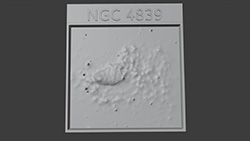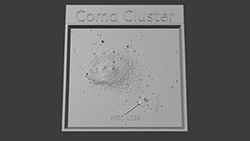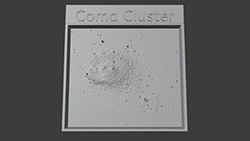CXC Home | Search | Help | Image Use Policy | Latest Images | Privacy | Accessibility | Glossary | Q&A
1
X-ray, & Optical Images of NGC 4839Credit: X-ray: Chandra: NASA/SAO/Univ. of Alabama/M. S. Mirakhor; XMM-Newton: ESA; Optical: SDSS
The NGC 4839 group of galaxies is plunging into the Coma galaxy cluster and leaving behind a tail of superheated gas. Using Chandra, astronomers confirmed this is the longest known tail behind a galaxy group, which informs how galaxy clusters — some of the largest structures in the Universe — grow to their enormous sizes. XMM-Newton and Sloan Digital Sky Survey data show the full field image of the Coma cluster. The close-up is the Chandra image of the region. The tail behind NGC 4839 is seen from left to right in the Chandra image, which has been rotated so that north is about 30 degrees to the left of vertical.
2
3D Printable Files: NGC 4839 (3D Print Credit: NASA/CXC/A. Jubett, using software by Tactile Universe/N. Bonne & C. Krawczyk & Blender)
This release features three tactile plates of a galaxy group plunging into a galaxy cluster, one of the largest structures in the universe. The first two plates, both labeled “Coma Cluster,” show the NGC 4839 galaxy group approaching the heart of the Coma Galaxy cluster. The third plate, labeled “NGC 4839,” is a closeup of the galaxy group and its extraordinary tail.
The wide field of view in the first two plates depicts the Coma galaxy cluster as a large gas cloud with a hazy core. Sitting to our left of center, this cloud-within-a-cloud is dotted with hundreds of pointy specks. Each speck is a distinct galaxy. At the lower right of this plate, a smaller cloud approaches. This is the galaxy group NGC 4839 and its comet-like tail. This cloud is vaguely shaped like a slice of pie, with a protruding dot at the tip. This tip points toward the core as it enters the outer edge of the cluster’s gas cloud. The cluster, the group, and the cloud around them are set against a more sparse, starry sky. In these two plates, they are presented using data from the XMM-Newton observatory, and the Sloan Digital Sky Survey. In one plate, an arrow labeled “NGC 4839” points directly to the tip of NGC 4839.
The third plate is a close up of the approaching galaxy group, which is much less pie-shaped from this perspective. This plate using Chandra data has been rotated such that the cluster is traveling horizontally toward our left, not our upper left as in the previous two plates. At the tip of the galaxy group is a large protruding dot. This is the ‘Head’ of the galaxy group. Here, the cloud trailing behind the head is raised and flecked with pointy specks. This is a tail of hot gas stripped off the galaxy group’s head as it plunges into the cloud of gas surrounding the Coma cluster. This comet-like tail is 1.5 million light-years long, and is filled with key ingredients to make future generations of stars and planets.
The wide field of view in the first two plates depicts the Coma galaxy cluster as a large gas cloud with a hazy core. Sitting to our left of center, this cloud-within-a-cloud is dotted with hundreds of pointy specks. Each speck is a distinct galaxy. At the lower right of this plate, a smaller cloud approaches. This is the galaxy group NGC 4839 and its comet-like tail. This cloud is vaguely shaped like a slice of pie, with a protruding dot at the tip. This tip points toward the core as it enters the outer edge of the cluster’s gas cloud. The cluster, the group, and the cloud around them are set against a more sparse, starry sky. In these two plates, they are presented using data from the XMM-Newton observatory, and the Sloan Digital Sky Survey. In one plate, an arrow labeled “NGC 4839” points directly to the tip of NGC 4839.
The third plate is a close up of the approaching galaxy group, which is much less pie-shaped from this perspective. This plate using Chandra data has been rotated such that the cluster is traveling horizontally toward our left, not our upper left as in the previous two plates. At the tip of the galaxy group is a large protruding dot. This is the ‘Head’ of the galaxy group. Here, the cloud trailing behind the head is raised and flecked with pointy specks. This is a tail of hot gas stripped off the galaxy group’s head as it plunges into the cloud of gas surrounding the Coma cluster. This comet-like tail is 1.5 million light-years long, and is filled with key ingredients to make future generations of stars and planets.
3D Printable Files: Coma Cluster/NGC 4839 (Labeled)
(3D Print Credit: NASA/CXC/A. Jubett, using software by Tactile Universe/N. Bonne & C. Krawczyk & Blender)
(3D Print Credit: NASA/CXC/A. Jubett, using software by Tactile Universe/N. Bonne & C. Krawczyk & Blender)
3D Printable Files: Coma Cluster/NGC 4839 (Unlabeled)
(3D Print Credit: NASA/CXC/A. Jubett, using software by Tactile Universe/N. Bonne & C. Krawczyk & Blender)
(3D Print Credit: NASA/CXC/A. Jubett, using software by Tactile Universe/N. Bonne & C. Krawczyk & Blender)
Return to: Galaxies Go on a Deep Dive and Leave Fiery Tail Behind (June 6, 2023)

















